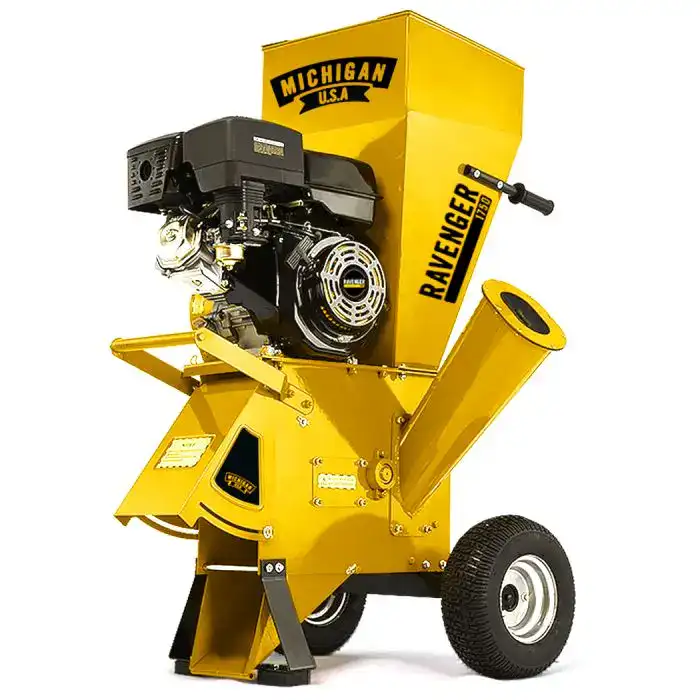Mulcher Chipper Price & Review: Michigan 15HP 420CC Power & Value
Picture this: It’s late spring, and you’re staring at a growing pile of storm debris in the backyard—or maybe you’re a firefighter prepping a station’s firebreak ahead of the dry season. Whether you’re a homeowner, renter, rural property owner, or part of an emergency crew, there’s one tool that pops up in every real-world prep and recovery chat: a tough, reliable wood chipper mulcher.
But let’s be honest—choosing the right machine (and justifying the spend) can feel overwhelming. Is the Michigan 15HP 420CC Mulcher Chipper really up to the hype? Does it handle big jobs, or just backyard trimmings? How does the price stack up for everyday Aussies—and is it safe for both families and frontliners?
In this friendly, no-nonsense review, we’ll unpack the Michigan’s real-world power, versatility, and price, share hands-on stories from both households and the fireground, walk you through common mistakes and must-knows, and help you decide if it fits your needs—whether you’re tidying your block, managing bushfire risk, or just clearing up after a wild summer storm.
When it comes to reliable backyard and fireground clearing, many Australians have turned to the Michigan 15HP 420CC Commercial Wood Chipper Mulcher for its blend of muscle, price, and straightforward design. Below, we dig into real experiences and what you can expect from this powerhouse—before you buy or hire one for your property or team.
Why Mulching Matters—At Home and on the Fireground
For most families, chipping branches and reducing garden debris isn’t just about a neat yard—it’s a big tick for fire safety, pest control, and keeping storm drains clear. If you’re living on a bush block or near grasslands, mulching can mean the difference between a safe boundary and a pile of kindling waiting for the next fire season.
On the fireground, crews and community wardens use chippers to help build and maintain control lines, clear fallen trees after storms, and keep access tracks safe for trucks and teams. It’s not just “nice-to-have” gear—it’s frontline risk management.
The Michigan 15HP 420CC Mulcher Chipper: Power, Specs & Versatility
Key Features at a Glance
- 15HP, 420CC OHV engine (petrol, pull-start with electric backup)
- Heavy-duty steel build (commercial grade)
- Handles up to 102mm (4-inch) branches
- Easy tow (large wheels, tow hitch)
- Wide-feed hopper for bundles of green waste
- Safety guards, auto-shutoff, and emergency stop
Real-World Use: The Good Stuff
This isn’t a “just for gardeners” machine—it’s built for Aussies who need to get through jobs quickly, safely, and with less back strain. Whether you’re feeding it big tree limbs after a storm or tackling a fire break, the Michigan’s engine starts reliably, chews through most hardwoods, and keeps going as long as you keep it fuelled and oiled.
Feedback from both home users and brigade tool officers points to its:
Easy towing (small tractors, utes, ride-on mowers),
no-nonsense maintenance (oil changes, blade swaps), and
quick clearout when jobs pile up fast.
What’s the Price—And Is It Worth It?
Let’s cut through the sales talk: At the time of writing, the Michigan 15HP 420CC sits in the $1,750–$2,500 range (retail or direct online) depending on season, deals, and freight. That’s not “pocket change” for most households, but if you compare hire costs for big cleanup jobs—or the bill for removing fallen trees after a storm—it can pay for itself within a season or two.
For fire brigades, landcare groups, or rural businesses, this chipper makes sense as a shared asset. Many crews have bought them together, split costs, or even loaned them out to neighbours—saving on contractor fees and building community resilience.
Setup, Safety, and Real-World Tips: At Home and On the Fireground
For Homeowners, Renters, and Small Blocks:
- Plan where you’ll chip: Pick a clear, level spot, ideally with wind at your back to avoid dust and chips flying toward your house, pets, or kids.
- Check fuel and oil before every start—treat it like your mower or whipper snipper, but expect a bigger thirst.
- Feed branches butt-end first; take your time and never force green, sappy stuff too fast.
- Wear gloves, safety glasses, boots, and ear protection—this machine is loud and spits chips with force.
- Keep kids, pets, and anyone not using PPE well away—set a “no-go” zone around the hopper and discharge chute.
- Stop and clear jams with the engine off and key out. Never, ever reach in with the power on.
For Fire Crews, Rural Users, and Large Properties:
- Buddy up—chipping is safer (and faster) with a spotter and an operator, especially on uneven ground or near tracks.
- Rotate operators every 30–40 minutes to avoid fatigue and keep alert. Heat and noise can creep up on you.
- Carry a first aid kit, fire extinguisher, and mobile phone. If you’re chipping near dry grass, have a hose or water knapsack ready.
- Check blade sharpness weekly in heavy season—blunt blades mean jams, smoke, and hard work.
- Clear and inspect the work zone before and after each use—look for trip hazards, fuel spills, and anything left in the feed area.
What Do Real Users Say? Feedback from Aussie Families and Firefighters
Here’s the honest verdict from people who’ve bought, borrowed, or managed these chippers over a few seasons—straight from backyard chat groups and brigade gear sheds:
- “Starts first go (if you prime it right)” – common praise from DIYers and tool officers alike.
- “Chews through big limbs, but hates old ropey palm fronds” – try to keep out stringy or fibrous materials.
- “Tows behind the ride-on easy, but mind the weight” – on wet ground, heavy chippers can bog in, so plan your path.
- “Saved us hundreds after the last windstorm” – a frequent theme in reviews from rural and suburban owners.
- “Bit noisy—bring earplugs and warn the neighbours” – expect up to 110db at full throttle.
Most users say the Michigan 15HP 420CC Commercial Wood Chipper Mulcher is a “workhorse, not a show pony.” You’ll need to do basic oil and blade maintenance, but the time saved on hauling and burning piles is worth it for most.
Little-Known Tips and Common Mistakes (From Both Sides of the Fence)
After years of cleanups and community projects, here’s what most people wish they’d known before starting:
- Don’t overfeed the hopper—wait until the engine clears before adding more. Jams are the number one cause of downtime (and frustration).
- Keep water away from the electrics—hose down the outside only when the engine is cold and the plug is capped.
- Never chip wet, sappy wood—it clogs blades fast and can cause stalls. Let branches dry for a day if possible.
- Don’t use your hands to push debris in—use a stick or the provided pusher. Even the best operators have close calls when tired.
- Service before storage—old fuel, gum, and flat batteries are the main culprits when it “won’t start” after a break.
- Log every use in your maintenance book—especially if sharing with a crew or neighbours. It saves arguments later.
And here’s a tip from the fireground: Always check for stones, wire, or fence staples in the debris before feeding. Even one hidden nail can kill a $100 blade.
Who Should Use the Michigan Mulcher Chipper—and Who Shouldn’t?
This chipper suits most Aussies with larger yards, blocks, farms, or shared rural land. It’s a real asset for:
- Households with bush or large garden cleanups
- Small landholders wanting to control burn piles and reduce fire risk
- Fire brigades, SES, and community teams looking for reliable gear
- Groups pooling resources (shared tool shed model works well)
- Businesses with landscape, tree, or storm recovery work
If you’ve only got a small suburban patch or do minimal pruning, a smaller electric unit may be more your speed. But for anyone facing “real” debris, this is the kind of tool that saves time, effort, and (frankly) your back.
Want more practical gear reviews and bushfire readiness tips? Check out our guides:
- How to Prepare for Fire Season & Grass Fires
- Understanding Bushfire Attack Levels (BAL) for Your Property
- Ultimate Campfire Safety Tips: Setup & Shutdown
FAQs: Using the Michigan 15HP 420CC Mulcher Chipper
Q: Is this chipper safe for older users or people with limited strength?
Yes, but only if you follow the safety steps—always use the electric start (if fitted), never force heavy limbs alone, and avoid operating on slopes. If you’re unsure, have a helper on hand or consider smaller jobs at a time.
Q: What regular maintenance is needed to keep it running?
Check oil and fuel each session, clean the air filter weekly, and sharpen blades every 8–10 hours of chipping. If sharing the machine, log each use and do a quick safety check before each job.
Q: Can this chipper handle palm fronds and vines?
It’ll manage some, but stringy, fibrous material can jam the blades. For best results, chip woody branches only, and dispose of tough palms or vines separately.
Q: What’s the noise level like—should I warn the neighbours?
It’s loud—on par with a ride-on mower or small generator. Ear protection is a must for users, and it’s worth letting neighbours know before a big chipping session.
Q: Any special advice for fire brigades or emergency crews?
Always chip with a buddy, rotate crews, and inspect debris for hidden nails or wire. Document use in the gear log, and keep a water extinguisher handy—especially during fire season or hot, windy days.
Take Action for a Safer, Cleaner Property—Start Small, Think Big
Whether you’re chipping your first storm cleanup, clearing a firebreak, or kitting out your brigade shed, the right tool makes all the difference. Don’t rush—talk to neighbours, compare stories, and decide what fits your needs. Share this guide with your crew or community, and remember: even a few hours with a chipper can set you up for a safer, tidier season ahead.



